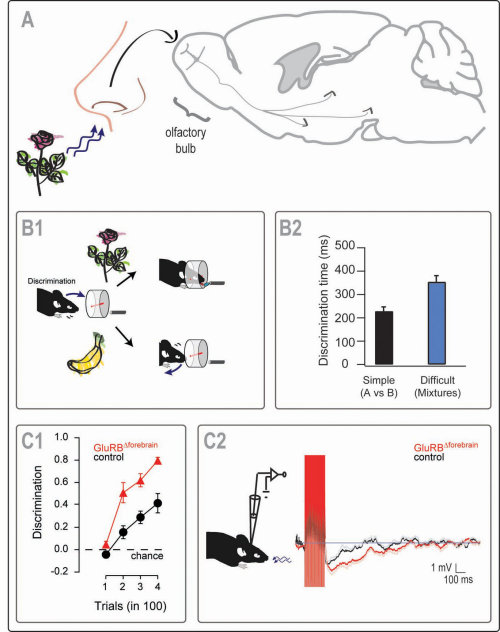Current Research
Our central aim is to understand how complex behaviour emerges from the properties of molecules, cells and ensembles of cells. The model employed is the olfactory system of mice.
To capture how smells are processed we modify specific selected brain areas - in particular the olfactory bulb - using transgenic mice, pharmacological tools or targeted virus injections. We then probe how these specific modifications alter the neural networks and the resulting cellular function and physiology in vivo and in vitro. Ultimately, we perform quantitative behavioural tasks in such modified mice.
Combining these genetic, physiological and behavioural techniques with computational modelling approaches we aim to elucidate the cellular basis of olfactory behaviour and ultimately more general complex behaviour.
|
(A) Scheme of the olfactory system: olfactory receptor neurons in the nose project to mitral cells in the olfactory bulb that in turn project to a variety of brain areas. |
 |
|
(B) Odor discrimination in mice is fast but depends on stimulus similarity (adapted from Abraham et al 2004) |
|
|
(C) Ablating the AMPA receptor subunit GluR-B in the forebrain improves odor learning/ discrimination (C1, from Shimshek et al 2005) and increases inhibition in the olfactory bulb (C2, whole-cell recording in vivo, from Abraham et al, submitted). |
Literatur
- Schaefer,A.T., and Margrie,T.W. (2007). Spatio-temporal representations in the olfactory system. Trends in Neurosciences, 30: 92-100
- Schaefer,A.T., Angelo,K., Spors,H., and Margrie,T.W. (2006). Neuronal oscillations enhance stimulus discrimination by ensuring action potential precision. PLoS Biology, 4:e163
- Shimshek,D.R., Bus,T., Kim,J., Mihaljevic,A., Mack,V., Seeburg,P.H., Sprengel,R., and Schaefer,A.T. (2005). Enhanced Odor Discrimination and Impaired Olfactory Memory by Spatially Controlled Switch of AMPA Receptors. PLoS Biology, 3:e354
- Abraham,N.*, Spors,H.*, Carleton,A., Margrie,T.W., Kuner,T., and Schaefer,A.T.(2004) Maintaining accuracy at the expense of speed: Stimulus similarity defines odor discrimination time in mice. Neuron 44: 865-876
- Margrie,T.W. and Schaefer,A.T. (2003). Theta oscillation coupled spike latencies yield computational vigour in a mammalian sensory system. Journal of Physiology, 546:363-374.

